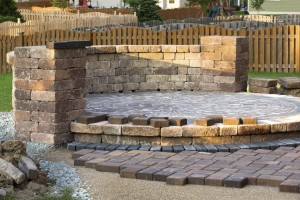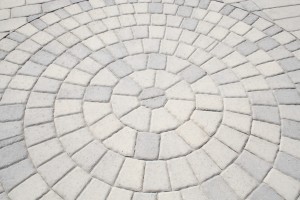All About Polymeric Sand
What is Polymeric Sand?

Every revolution needs a foundation. For the Interlock Revolution, that foundation is polymeric sand.
One of the recent labour-saving developments in landscaping supplies and hardscaping is the widespread availability of polymeric sand, but many homeowners may not know about this marvelous product.
When finishing off a patio, walkway or driveway with pavers, you have to fill all gaps between pavers with sand to improve the performance of your interlocking pavers.
Polymeric sand accomplishes this task better than traditional torpedo sand because of its composition:
- Fine quartz and silica sand
- Proprietary polymer—a water-activated binder to hold the sand in place
- Other ingredients—some manufacturers add portland cement and colourants
Put down dry, polymeric sand bonds when wet, drying hard and helping to lock your hardscape in place.
At Grand River, we carry Permapro polymeric sand, sold in convenient 30 kg bags. This superior product can speed your weekend project and produce professional-looking results.
Benefits of Polymeric Sand
When putting in a single patio or garden walkway, most homeowners cannot instantly develop the skills of practiced stone masons. Getting the sand between interlocking pavers is a challenge. Getting enough sand between the cracks is harder still, and keeping the sand in place through all weather often requires new sand and frequent maintenance.
Polymeric sand is a favourite among weekend masons because it goes in dry and hardens when wet. It does not shift, does not flow out through the bottom of the pavers, and prevents weeds from sprouting between your pavers.
Using polymeric sand helps lock pavers together, maintaining joint spacing for years with minimal upkeep. Insect pests are discouraged by the dense polymeric sand, too, so your favourite backyard dining spot is not ruined by foraging ants.
How to Use Polymeric Sand
Because polymeric sand will stick like glue to whatever wet surface it contacts, only apply the product when rain is not in the forecast. The steps are straightforward:
- After laying your pavers, bricks or flagstones, sweep polymeric sand into all joints
- Compact or tamp the pavers and sand
- Sweep in another round of polymeric sand
- Compact again
- Sweep in, but do not tamp, a third round of polymeric sand to get it as close to the tops of pavers as possible
- Ensure no sand is sitting on the pavers themselves, even if you have to sweep individual pieces; polymeric sand is hard to remove once wet
- Spray water mist over the entire paved or hardscaped area, from high point to low point
- Let sit for 10 to 15 minutes, then rewet with a light mist
- Allow 24 hours for full curing
Maintaining Hardscaping with Polymeric Sand

Even a few small grains will adhere strongly to paver surfaces if they are moistened, because of the polymer binder mixed with them. Care must be taken to remove stray pieces if they do attach to the decorative flagstone surface—you could scratch the stone surface using metal tools, but nylon scrub brushes may fail to remove the polymeric sand.
After a full day of curing, give everything a final brushing. You can seal the pavers to preserves the stones’ beautiful colour and to match the polymeric sand’s durability. Because you have colour choices with your polymeric sand, you can either match your paver colour or choose a complementary colour to emphasize the joint lines.
After a harsh Canadian winter, seasonal maintenance on interlocked pavers is easier using polymeric sand, because less material will have shifted from the bricks and flagstones, weeds are less likely to sprout, and the surface stays even.
We’re Your Source for Polymeric Sand
To learn more about the many benefits of polymeric sand, or for more help solving your landscaping and hardscaping problems, contact us at Grand River Natural Stone, Ltd.

